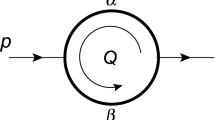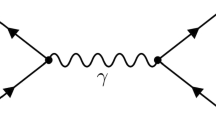Abstract
The renormalization group method allows improving the properties of the QCD perturbative power series in the ultraviolet region. But it ultimately leads to unphysical singularities of observables in the infrared domain. The analytic perturbation theory is the next step in improving the perturbative expansions. Specifically, it involves an additional analyticity requirement based on the causality principle and implemented in the Källen-Lehmann and Jost-Lehmann representations. This approach eliminates spurious singularities of the perturbative power series and enhances the stability of the series with respect to both higher-loop corrections and the choice of the renormalization scheme. This paper is an overview of the basic stages in developing the analytic perturbation theory in QCD, including its recent applications to describing hadronic processes.
Similar content being viewed by others
References
N. N. Bogoliubov, A. A. Logunov, and D. V. Shirkov, Zh. Eksp. Teor. Fiz., 37, No. 3(9), 805 (1959).
N. N. Bogoliubov and D. V. Shirkov, Dokl. Akad. Nauk SSSR, 103, 391 (1955).
N. N. Bogoliubov and D. V. Shirkov, Nuovo Cimento, 3, 845 (1956).
N. N. Bogoliubov and D. V. Shirkov, Introduction to the Theory of Quantum Fields [in Russian], Nauka, Moscow (1957, 1973, 1976, 1986); English transl., Wiley, New York (1959, 1980).
N. N. Bogoliubov, A. A. Logunov, and I. T. Todorov, Foundations of the Axiomatic Approach in Quantum Field Theory [in Russian], Nauka, Moscow (1969); English transl.: Introduction to Axiomatic Quantum Field Theory, Benjamin, Reading, Mass. (1975); N. N. Bogoliubov, A. A. Logunov, A. I. Oksak, and I. T. Todorov, General Principles of Quantum Field Theory [in Russian], Nauka, Moscow (1987); English transl., Kluwer, Dordrecht (1990).
P. A. M. Dirac, “Theorie du positron,” in: Structure et propertiétes des noyaux atomiques (Septiéme Conseil du Physique Solvay, Bruxelles, 22–29 October 1933, J. Cockcroft et al., eds.), Gauthier-Villars, Paris (1934), p. 203.
D. V. Shirkov and I. L. Solovtsov, JINR Rapid Commun., 76, 5 (1996); hep-ph/9604363 (1996).
D. V. Shirkov and I. L. Solovtsov, Phys. Rev. Lett., 79, 1209 (1997); hep-ph/9704333 (1997).
K. A. Milton and I. L. Solovtsov, Phys. Rev. D, 55, 5295 (1997); hep-ph/9611438 (1996).
K. A. Milton and I. L. Solovtsov, Phys. Rev. D, 59, 107701 (1999); hep-th/9812171 (1998).
N. N. Bogoliubov and D. V. Shirkov, Dokl. Akad. Nauk SSSR, 105, 685 (1955).
J. Schwinger, Proc. Natl. Acad. Sci. USA, 71, 3024, 5047 (1974).
K. A. Milton and O. P. Solovtsova, Phys. Rev. D, 57, 5402 (1998); hep-ph/9710316 (1997).
B. A. Magradze, Internat. J. Mod. Phys. A, 15, 2715 (2000); hep-ph/0010070 (2000); D. S. Kurashev and B. A. Magradze, Theor. Math. Phys., 135, 531 (2003); hep-ph/0104142 (2001).
F. J. Dyson, Phys. Rev., 85, 631 (1952).
D. V. Shirkov, Lett. Math. Phys., 1, 179 (1976); Lett. Nuovo Cimento, 18, 452 (1977).
D. V. Shirkov, Theor. Math. Phys., 40, 785 (1979); D. I. Kazakov and D. V. Shirkov, Fortsch. Phys., 28, 465 (1980).
D. V. Shirkov, Theor. Math. Phys., 119, 438 (1999); hep-th/9810246 (1998); Lett. Math. Phys., 48, 135 (1999).
D. V. Shirkov, Theor. Math. Phys., 136, 893 (2003); hep-th/0210013 (2002).
A. V. Radyushkin, JINR Rapid Commun., 78, 96 (1996); hep-ph/9907228 (1999); N. V. Krasnikov and A. A. Pivovarov, Phys. Lett. B, 116, 168 (1982); J. D. Bjorken, “Two topics in quantum chromodynamics,” in: Particle Physics: Cargèse, 1989 (NATO Sci. Ser. B, Vol. 223, M. Lévy, J. L. Basdevant, M. Jacob, and D. Speiser, eds.), Plenum, New York (1990), p. 217.
I. Caprini and J. Fischer, Phys. Rev. D, 62, 054007 (2000); hep-ph/0002016 (2000); Eur. Phys. J. C, 24, 127 (2002); hep-ph/0110344 (2001).
D. V. Shirkov, Nucl. Phys. B, 371, 467 (1992); Theor. Math. Phys., 93, 1403 (1992).
D. V. Shirkov and S. V. Mikhailov, Z. Phys. C, 63, 463 (1994); hep-ph/9401270 (1994).
W. J. Marciano, Phys. Rev. D, 29, 580 (1984).
D. V. Shirkov, Theor. Math. Phys., 127, 409 (2001); hep-ph/0012283 (2000).
D. V. Shirkov, Eur. Phys. J. C, 22, 331 (2001); hep-ph/0107282 (2001).
A. I. Alekseev and B. A. Arbuzov, Modern Phys. Lett. A, 13, 1747 (1998); hep-ph/9704228 (1997); 20, 103 (2005); hep-ph/0411339 (2004); A. I. Alekseev, Theor. Math. Phys., 145, 1559 (2005).
A. V. Nesterenko and J. Papavassiliou, J. Phys. G, 32, 1025 (2006); hep-ph/0511215 (2005).
G. Cvetič, C. Valenzuela, and I. Schmidt, “A modification of minimal analytic QCD at low energies,” hep-ph/0508101 (2005); G. Cvetič and C. Valenzuela, J. Phys. G, 32, L27 (2006); hep-ph/0601050 (2006).
I. L. Solovtsov and D. V. Shirkov, Theor. Math. Phys., 120, 1220 (1999); hep-ph/9909305 (1999).
D. V. Shirkov and A. V. Zayakin, “Analytic perturbation theory for practitioners and Upsilon decay,” Phys. Atomic Nuclei (to appear); hep-ph/0512325 (2005).
O. P. Solovtsova, JETP Lett., 64, 714 (1996); K. A. Milton, I. L. Solovtsov, and O. P. Solovtsova, Phys. Lett. B, 415, 104 (1997); hep-ph/9706409 (1997); O. P. Solovtsova, Theor. Math. Phys., 134, 365 (2003); K. A. Milton and O. P. Solovtsova, Internat. J. Mod. Phys. A, 17, 3789 (2002).
K. A. Milton, I. L. Solovtsov, O. P. Solovtsova, and V. I. Yasnov, Eur. Phys. J. C, 14, 495 (2000); hep-ph/0003030 (2000).
D. V. Shirkov and I. L. Solovtsov, “e + e − Annihilation at low energies in analytic approach to QCD,” in: Proc. Intl. Workshop on (e + e − ) Collisions from φ to J/Ψ (Novosibirsk, Russia, March 1–5, 1999, G. V. Fedotovich and S. I. Redin, eds.), Budker Inst. Nucl. Phys., Novosibirsk, Russia (2000), p. 122; hep-ph/9906495 (1999); K. A. Milton, I. L. Solovtsov, and O. P. Solovtsova, Phys. Rev. D, 64, 016005 (2001); hep-ph/0102254 (2001).
E. C. Poggio, H. R. Quinn, and S. Weinberg, Phys. Rev. D, 13, 1958 (1976).
A. C. Mattingly and P. M. Stevenson, Phys. Rev. D, 49, 437 (1994); hep-ph/9307266 (1993).
S. Eidelman, F. Jegerlehner, A. L. Kataev, and O. Veretin, Phys. Lett. B, 454, 369 (1999); hep-ph/9812521 (1998).
I. L. Solovtsov and D. V. Shirkov, Phys. Lett. B, 442, 344 (1998); hep-ph/9711251 (1997).
K. A. Milton, I. L. Solovtsov, and O. P. Solovtsova, Phys. Lett. B, 439, 421 (1998); hep-ph/9809510 (1998); Phys. Rev. D, 60, 016001 (1999); hep-ph/9809513 (1998).
K. A. Milton, I. L. Solovtsov, and O. P. Solovtsova, Modern Phys. Lett. A, 21, 1355 (2006); hep-ph/0512209 (2005).
M. Davier, S. Eidelman, A. Höcker, and Z. Zhang, Eur. Phys. J. C, 31, 503 (2003); hep-ph/0308213 (2003); A. Höcker, “The hadronic contribution to the muon g − 2,” in: Proc. 32nd Intl. Conf. on High-Energy Physics (ICHEP’04) (Beijing, China, 16–22 August 2004, H. Chen et al., eds.), Vol. 2, World Scientific, Singapore (2005), p. 710; hep-ph/0410081 (2004); G. W. Bennett et al. (Muon g − 2 Collab.), Phys. Rev. Lett., 92, 161802 (2004); hep-ex/0401008 (2004); A. Czarnecki, Nucl. Phys. B (Proc. Suppl.), 144, 201 (2005).
K. Hagiwara, A. D. Martin, D. Nomura, and T. Teubner, Phys. Rev. D, 69, 093003 (2004); hep-ph/0312250 (2003).
M. Baldicchi and G. M. Prosperi, Phys. Rev. D, 66, 074008 (2002); hep-ph/0202172 (2002); AIP Conf. Proc., 756, 152 (2005); hep-ph/0412359 (2004).
N. G. Stefanis, W. Schroers, and H.-Ch. Kim, Eur. Phys. J. C, 18, 137 (2000); hep-ph/0005218 (2000).
A. P. Bakulev et al., Phys. Rev. D, 70, 033014, Erratum, 079906 (2004); hep-ph/0405062 (2004).
A. P. Bakulev, A. I. Karanikas, and N. G. Stefanis, Phys. Rev. D, 72, 074015 (2005); hep-ph/0504275 (2005).
N. G. Stefanis et al., “Fractional analytic perturbation theory in QCD and exclusive reaction,” hep-ph/0601270 (2006).
R. Jost and H. Lehmann, Nuovo Cimento, 5, 1598 (1957).
N. N. Bogoliubov, V. S. Vladimirov, and A. N. Tavkhelidze, Theor. Math. Phys., 12, 839 (1972).
N. N. Bogoliubov and D. V. Shirkov, Dokl. Akad. Nauk SSSR, 113, 529 (1957).
B. Geyer, D. Robaschik, and E. Wieczorek, Fortschr. Phys., 27, 75 (1979); Sov. J. Part. Nucl., 11, 52 (1980).
H. Georgi and H. D. Politzer, Phys. Rev. D, 14, 1829 (1976).
I. L. Solovtsov, Part. Nucl. Lett., 4[101], 10 (2000).
Author information
Authors and Affiliations
Additional information
__________
Translated from Teoreticheskaya i Matematicheskaya Fizika, Vol. 150, No. 1, pp. 152–176, January, 2007.
Rights and permissions
About this article
Cite this article
Shirkov, D.V., Solovtsov, I.L. Ten years of the analytic perturbation theory in QCD. Theor Math Phys 150, 132–152 (2007). https://doi.org/10.1007/s11232-007-0010-7
Received:
Issue Date:
DOI: https://doi.org/10.1007/s11232-007-0010-7




